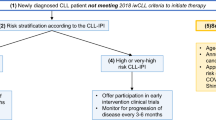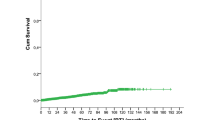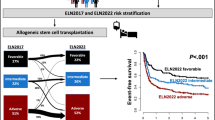Abstract
The management of chronic lymphocytic leukemia (CLL) has historically relied on ‘watchful waiting’ and palliative approaches to therapy. However, the course of disease is highly variable and a substantial proportion of patients with early-stage CLL develop rapidly progressive disease requiring therapy. In recent decades, numerous clinical and biological prognostic markers that are predictive of decreased survival outcomes, disease progression and/or resistance to therapy, and that may play a role in defining the subgroups of patients with ‘high-risk’ CLL have been identified. At the same time, highly effective treatment modalities have become available with the advent of chemoimmunotherapy combinations and allogeneic stem cell transplantation. Thus, we are approaching an era when patients with CLL may potentially benefit from individualized risk assessments based on prognostic markers and when specific therapies may be offered to the subgroup of patients with high-risk disease. This review provides a brief overview of newer biological prognostic markers, discusses the challenges associated with identifying the subgroup of patients with high-risk CLL and further aims to provide recommendations on how prognostic markers may be used to assess high-risk subgroups in different clinical situations in CLL.
This is a preview of subscription content, access via your institution
Access options
Subscribe to this journal
Receive 12 print issues and online access
$259.00 per year
only $21.58 per issue
Buy this article
- Purchase on Springer Link
- Instant access to full article PDF
Prices may be subject to local taxes which are calculated during checkout

Similar content being viewed by others
References
Chiorazzi N, Rai KR, Ferrarini M . Chronic lymphocytic leukemia. N Engl J Med 2005; 352: 804–815.
Zwiebel JA, Cheson BD . Chronic lymphocytic leukemia: staging and prognostic factors. Semin Oncol 1998; 25: 42–59.
Ries LAG, Melbert D, Krapcho M, Mariotto A, Miller BA, Feuer EJ et al. (eds) SEER Cancer Statistics Review, 1975–2004. National Cancer Institute: Bethesda, MD, 2005: available at: http://seer.cancer.gov/statfacts/html/clyl.html, accessed March 21, 2007.
Binet JL, Lepoprier M, Dighiero G, Charron D, d’Athis P, Vaugier G et al. A clinical staging system for chronic lymphocytic leukemia: prognostic significance. Cancer 1977; 40: 855–864.
Rai KR, Sawitsky A, Cronkite EP, Chanana AD, Levy RN, Pasternack BS . Clinical staging of chronic lymphocytic leukemia. Blood 1975; 46: 219–234.
Dighiero G, Maloum K, Desablens B, Cazin B, Navarro M, Leblay R et al. Chlorambucil in indolent chronic lymphocytic leukemia French Cooperative Group on Chronic Lymphocytic Leukemia. N Engl J Med 1998; 338: 1506–1514.
Mauro FR, Foa R, Giannarelli D, Cordone I, Crescenzi S, Pescarmona E et al. Clinical characteristics and outcome of young chronic lymphocytic leukemia patients: a single institution study of 204 cases. Blood 1999; 94: 448–454.
Molica S, Alberti A . Prognostic value of the lymphocyte doubling time in chronic lymphocytic leukemia. Cancer 1987; 60: 2712–2716.
Montserrat E, Sanchez-Bisono J, Vinolas N, Rozman C . Lymphocyte doubling time in chronic lymphocytic leukaemia: analysis of its prognostic significance. Br J Haematol 1986; 62: 567–575.
Shanafelt TD, Geyer SM, Kay NE . Prognosis at diagnosis: integrating molecular biologic insights into clinical practice for patients with CLL. Blood 2004; 103: 1202–1210.
Hallek M, Wanders L, Ostwald M, Busch R, Senekowitsch R, Stern S et al. Serum beta(2)-microglobulin and serum thymidine kinase are independent predictors of progression-free survival in chronic lymphocytic leukemia and immunocytoma. Leuk Lymphoma 1996; 22: 439–447.
Molica S, Levato D, Dell'Olio M, Matera R, Minervini M, Dattilo A et al. Cellular expression and serum circulating levels of CD23 in B-cell chronic lymphocytic leukemia. Implications for prognosis. Haematologica 1996; 81: 428–433.
Sarfati M, Chevret S, Chastang C, Biron G, Stryckmans P, Delespesse G et al. Prognostic importance of serum soluble CD23 level in chronic lymphocytic leukemia. Blood 1996; 88: 4259–4264.
Hallek M, Langenmayer I, Nerl C, Knauf W, Dietzfelbinger H, Adorf D et al. Elevated serum thymidine kinase levels identify a subgroup at high risk of disease progression in early, nonsmoldering chronic lymphocytic leukemia. Blood 1999; 93: 1732–1737.
Damle RN, Wasil T, Fais F, Ghiotto F, Valetto A, Allen SL et al. Ig V gene mutation status and CD38 expression as novel prognostic indicators in chronic lymphocytic leukemia. Blood 1999; 94: 1840–1847.
Hamblin TJ, Davis Z, Gardiner A, Oscier DG, Stevenson FK . Unmutated Ig V(H) genes are associated with a more aggressive form of chronic lymphocytic leukemia. Blood 1999; 94: 1848–1854.
Hamblin TJ, Orchard JA, Ibbotson RE, Davis Z, Thomas PW, Stevenson FK et al. CD38 expression and immunoglobulin variable region mutations are independent prognostic variables in chronic lymphocytic leukemia, but CD38 expression may vary during the course of the disease. Blood 2002; 99: 1023–1029.
Krober A, Seiler T, Benner A, Bullinger L, Bruckle E, Lichter P et al. V(H) mutation status, CD38 expression level, genomic aberrations, and survival in chronic lymphocytic leukemia. Blood 2002; 100: 1410–1416.
Seiler T, Dohner H, Stilgenbauer S . Risk stratification in chronic lymphocytic leukemia. Semin Oncol 2006; 33: 186–194.
Byrd JC, Gribben JG, Peterson BL, Grever MR, Lozanski G, Lucas DM et al. Select high-risk genetic features predict earlier progression following chemoimmunotherapy with fludarabine and rituximab in chronic lymphocytic leukemia: justification for risk-adapted therapy. J Clin Oncol 2005; 24: 437–443.
Del Poeta G, Del Principe MI, Consalvo MA, Maurillo L, Buccisano F, Venditti A et al. The addition of rituximab to fludarabine improves clinical outcome in untreated patients with ZAP-70-negative chronic lymphocytic leukemia. Cancer 2005; 104: 2743–2752.
Ritgen M, Lange A, Stilgenbauer S, Dohner H, Bretscher C, Bosse H et al. Unmutated immunoglobulin variable heavy-chain gene status remains an adverse prognostic factor after autologous stem cell transplantation for chronic lymphocytic leukemia. Blood 2003; 101: 2049–2053.
Gribben JG, Zahrieh D, Stephans K, Bartlett-Pandite L, Alyea EP, Fisher DC et al. Autologous and allogeneic stem cell transplantations for poor-risk chronic lymphocytic leukemia. Blood 2005; 106: 4389–4396.
Moreno C, Villamor N, Colomer D, Esteve J, Martino R, Nomdedeu J et al. Allogeneic stem-cell transplantation may overcome the adverse prognosis of unmutated VH gene in patients with chronic lymphocytic leukemia. J Clin Oncol 2005; 23: 3433–3438.
Ritgen M, Stilgenbauer S, von NN, Humpe A, Bruggemann M, Pott C et al. Graft-versus-leukemia activity may overcome therapeutic resistance of chronic lymphocytic leukemia with unmutated immunoglobulin variable heavy-chain gene status: implications of minimal residual disease measurement with quantitative PCR. Blood 2004; 104: 2600–2602.
Sorror ML, Maris MB, Sandmaier BM, Storer BE, Stuart MJ, Hegenbart U et al. Hematopoietic cell transplantation after nonmyeloablative conditioning for advanced chronic lymphocytic leukemia. J Clin Oncol 2005; 23: 3819–3829.
Del Principe MI, Del PG, Buccisano F, Maurillo L, Venditti A, Zucchetto A et al. Clinical significance of ZAP-70 protein expression in B-cell chronic lymphocytic leukemia. Blood 2006; 108: 853–861.
Del Poeta G, Maurillo L, Venditti A, Buccisano F, Epiceno AM, Capelli G et al. Clinical significance of CD38 expression in chronic lymphocytic leukemia. Blood 2001; 98: 2633–2639.
Ibrahim S, Keating M, Do KA, O'Brien S, Huh YO, Jilani I et al. CD38 expression as an important prognostic factor in B-cell chronic lymphocytic leukemia. Blood 2001; 98: 181–186.
Schroers R, Griesinger F, Trumper L, Haase D, Kulle B, Klein-Hitpass L et al. Combined analysis of ZAP-70 and CD38 expression as a predictor of disease progression in B-cell chronic lymphocytic leukemia. Leukemia 2005; 19: 750–758.
Pittner BT, Shanafelt TD, Kay NE, Jelinek DF . CD38 expression levels in chronic lymphocytic leukemia B cells are associated with activation marker expression and differential responses to interferon stimulation. Leukemia 2005; 19: 2264–2272.
Zucchetto A, Bomben R, Dal BM, Bulian P, Benedetti D, Nanni P et al. CD49d in B-cell chronic lymphocytic leukemia: correlated expression with CD38 and prognostic relevance. Leukemia 2006; 20: 523–525.
Nolz JC, Tschumper RC, Pittner BT, Darce JR, Kay NE, Jelinek DF . ZAP-70 is expressed by a subset of normal human B-lymphocytes displaying an activated phenotype. Leukemia 2005; 19: 1018–1024.
Rosenwald A, Alizadeh AA, Widhopf G, Simon R, Davis RE, Yu X et al. Relation of gene expression phenotype to immunoglobulin mutation genotype in B cell chronic lymphocytic leukemia. J Exp Med 2001; 194: 1639–1647.
Wiestner A, Rosenwald A, Barry TS, Wright G, Davis RE, Henrickson SE et al. ZAP-70 expression identifies a chronic lymphocytic leukemia subtype with unmutated immunoglobulin genes, inferior clinical outcome, and distinct gene expression profile. Blood 2003; 101: 4944–4951.
Crespo M, Bosch F, Villamor N, Bellosillo B, Colomer D, Rozman M et al. ZAP-70 expression as a surrogate for immunoglobulin-variable-region mutations in chronic lymphocytic leukemia. N Engl J Med 2003; 348: 1764–1775.
Orchard JA, Ibbotson RE, Davis Z, Wiestner A, Rosenwald A, Thomas PW et al. ZAP-70 expression and prognosis in chronic lymphocytic leukaemia. Lancet 2004; 363: 105–111.
Krober A, Bloehdorn J, Hafner S, Buhler A, Seiler T, Kienle D et al. Additional genetic high-risk features such as 11q deletion, 17p deletion, and V3-21 usage characterize discordance of ZAP-70 and VH mutation status in chronic lymphocytic leukemia. J Clin Oncol 2006; 24: 969–975.
Rassenti LZ, Huynh L, Toy TL, Chen L, Keating MJ, Gribben JG et al. ZAP-70 compared with immunoglobulin heavy-chain gene mutation status as a predictor of disease progression in chronic lymphocytic leukemia. N Engl J Med 2004; 351: 893–901.
Tobin G, Thunberg U, Johnson A, Thorn I, Soderberg O, Hultdin M et al. Somatically mutated Ig V(H)3-21 genes characterize a new subset of chronic lymphocytic leukemia. Blood 2002; 99: 2262–2264.
Sheikholeslami MR, Jilani I, Keating M, Uyeji J, Chen K, Kantarjian H et al. Variations in the detection of ZAP-70 in chronic lymphocytic leukemia: comparison with IgV(H) mutation analysis. Cytometry B Clin Cytom 2006; 70: 270–275.
Grabowski P, Hultdin M, Karlsson K, Tobin G, Aleskog A, Thunberg U et al. Telomere length as a prognostic parameter in chronic lymphocytic leukemia with special reference to VH gene mutation status. Blood 2005; 105: 4807–4812.
Heintel D, Kienle D, Shehata M, Krober A, Kroemer E, Schwarzinger I et al. High expression of lipoprotein lipase in poor risk B-cell chronic lymphocytic leukemia. Leukemia 2005; 19: 1216–1223.
Dohner H, Stilgenbauer S, Benner A, Leupolt E, Krober A, Bullinger L et al. Genomic aberrations and survival in chronic lymphocytic leukemia. N Engl J Med 2000; 343: 1910–1916.
Austen B, Powell JE, Alvi A, Edwards I, Hooper L, Starczynski J et al. Mutations in the ATM gene lead to impaired overall and treatment-free survival that is independent of IGVH mutation status in patients with B-CLL. Blood 2005; 106: 3175–3182.
Thornton PD, Gruszka-Westwood AM, Hamoudi RA, Atkinson S, Kaczmarek P, Morilla RM et al. Characterisation of TP53 abnormalities in chronic lymphocytic leukaemia. Hematol J 2004; 5: 47–54.
Carter A, Lin K, Sherrington PD, Pettitt AR . Detection of p53 dysfunction by flow cytometry in chronic lymphocytic leukaemia. Br J Haematol 2004; 127: 425–428.
Pettitt AR, Sherrington PD, Stewart G, Cawley JC, Taylor AM, Stankovic T . p53 dysfunction in B-cell chronic lymphocytic leukemia: inactivation of ATM as an alternative to TP53 mutation. Blood 2001; 98: 814–822.
Lin K, Manocha S, Harris RJ, Matrai Z, Sherrington PD, Pettitt AR . High frequency of p53 dysfunction and low level of VH mutation in chronic lymphocytic leukemia patients using the VH3-21 gene segment. Blood 2003; 102: 1145–1146.
Carter A, Lin K, Sherrington PD, Atherton M, Pearson K, Douglas A et al. Imperfect correlation between p53 dysfunction and deletion of TP53 and ATM in chronic lymphocytic leukaemia. Leukemia 2006; 20: 737–740.
Lin K, Sherrington PD, Dennis M, Matrai Z, Cawley JC, Pettitt AR . Relationship between p53 dysfunction, CD38 expression, and IgV(H) mutation in chronic lymphocytic leukemia. Blood 2002; 100: 1404–1409.
Dewald GW, Brockman SR, Paternoster SF, Bone ND, O'Fallon JR, Allmer C et al. Chromosome anomalies detected by interphase fluorescence in situ hybridization: correlation with significant biological features of B-cell chronic lymphocytic leukaemia. Br J Haematol 2003; 121: 287–295.
Oscier DG, Gardiner AC, Mould SJ, Glide S, Davis ZA, Ibbotson RE et al. Multivariate analysis of prognostic factors in CLL: clinical stage, IGVH gene mutational status, and loss or mutation of the p53 gene are independent prognostic factors. Blood 2002; 100: 1177–1184.
Shanafelt TD, Witzig TE, Fink SR, Jenkins RB, Paternoster SF, Smoley SA et al. Prospective evaluation of clonal evolution during long-term follow-up of patients with untreated early-stage chronic lymphocytic leukemia. J Clin Oncol 2006; 24: 4634–4641.
Shanafelt TD, Jelinek D, Tschumper R, Schwager S, Nowakowski G, Dewald GW et al. Cytogenetic abnormalities can change during the course of the disease process in chronic lymphocytic leukemia. J Clin Oncol 2006; 24: 3218–3219.
Dicker F, Schnittger S, Haferlach T, Kern W, Schoch C . Immunostimulatory oligonucleotide-induced metaphase cytogenetics detect chromosomal aberrations in 80% of CLL patients: a study of 132 CLL cases with correlation to FISH, IgVH status, and CD38 expression. Blood 2006; 108: 3152–3160.
Mayr C, Speicher MR, Kofler DM, Buhmann R, Strehl J, Busch R et al. Chromosomal translocations are associated with poor prognosis in chronic lymphocytic leukemia. Blood 2006; 107: 742–751.
Dohner H, Fischer K, Bentz M, Hansen K, Benner A, Cabot G et al. p53 gene deletion predicts for poor survival and non-response to therapy with purine analogs in chronic B-cell leukemias. Blood 1995; 85: 1580–1589.
El Rouby S, Thomas A, Costin D, Rosenberg CR, Potmesil M, Silber R et al. p53 gene mutation in B-cell chronic lymphocytic leukemia is associated with drug resistance and is independent of MDR1/MDR3 gene expression. Blood 1993; 82: 3452–3459.
Lozanski G, Heerema NA, Flinn IW, Smith L, Harbison J, Webb J et al. Alemtuzumab is an effective therapy for chronic lymphocytic leukemia with p53 mutations and deletions. Blood 2004; 103: 3278–3281.
Zent CS, Call TG, Hogan WJ, Shanafelt TD, Kay NE . Update on risk-stratified management for chronic lymphocytic leukemia. Leuk Lymphoma 2006; 47: 1738–1746.
Wierda W, O'Brien S, Wen S, Faderl S, Garcia-Manero G, Thomas D et al. Chemoimmunotherapy with fludarabine, cyclophosphamide, and rituximab for relapsed and refractory chronic lymphocytic leukemia. J Clin Oncol 2005; 23: 4070–4078.
Pettitt AR, Matutes E, Oscier D . Alemtuzumab in combination with high-dose methylprednisolone is a logical, feasible and highly active therapeutic regimen in chronic lymphocytic leukaemia patients with p53 defects. Leukemia 2006; 20: 1441–1445.
Binet JL, Caligaris-Cappio F, Catovsky D, Cheson B, Davis T, Dighiero G et al. Perspectives on the use of new diagnostic tools in the treatment of chronic lymphocytic leukemia. Blood 2006; 107: 859–861.
Cheson BD, Bennett JM, Grever M, Kay N, Keating MJ, O'Brien S et al. National Cancer Institute-sponsored Working Group guidelines for chronic lymphocytic leukemia: revised guidelines for diagnosis and treatment. Blood 1996; 87: 4990–4997.
Author information
Authors and Affiliations
Corresponding author
Rights and permissions
About this article
Cite this article
Kay, N., O'Brien, S., Pettitt, A. et al. The role of prognostic factors in assessing ‘high-risk’ subgroups of patients with chronic lymphocytic leukemia. Leukemia 21, 1885–1891 (2007). https://doi.org/10.1038/sj.leu.2404802
Received:
Revised:
Accepted:
Published:
Issue Date:
DOI: https://doi.org/10.1038/sj.leu.2404802
Keywords
This article is cited by
-
The prognostic role of HBV infection in chronic lymphocytic leukemia
Journal of Cancer Research and Clinical Oncology (2018)
-
The SF3B1 inhibitor spliceostatin A (SSA) elicits apoptosis in chronic lymphocytic leukaemia cells through downregulation of Mcl-1
Leukemia (2016)
-
TCL1 transgenic mouse model as a tool for the study of therapeutic targets and microenvironment in human B-cell chronic lymphocytic leukemia
Cell Death & Disease (2016)
-
The tumor suppressor axis p53/miR-34a regulates Axl expression in B-cell chronic lymphocytic leukemia: implications for therapy in p53-defective CLL patients
Leukemia (2014)
-
Downregulation of IL-17-producing T cells is associated with regulatory T cell expansion and disease progression in chronic lymphocytic leukemia
Tumor Biology (2013)



